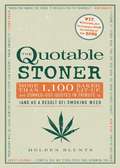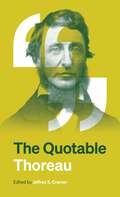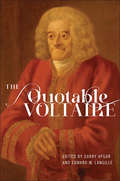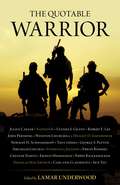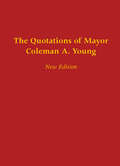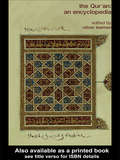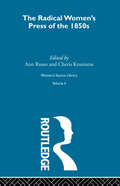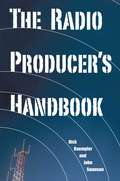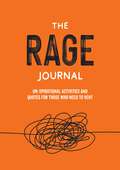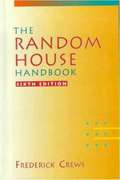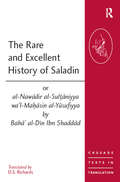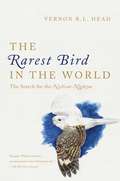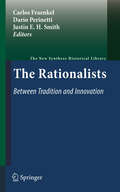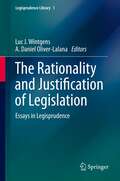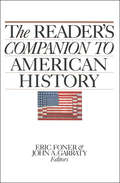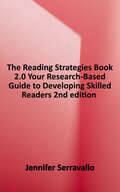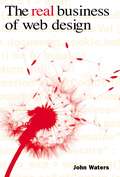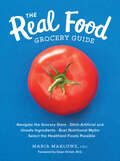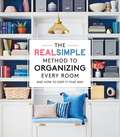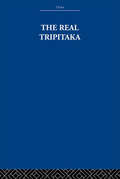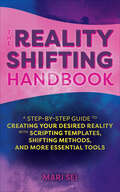- Table View
- List View
The Quotable Stoner
by Holden Blunts"I love my FedEx guy 'cause he's a drug dealer and he don't even know it . . . and he's always on time."--Mitch HedbergTalking about weed? It never gets old. There's just a whole lot to be said. And in this book, you'll find more than a thousand hilarious, half-baked quotes about marijuana and its (medicinal, calming, overall awesome) influence on movies, people, politics, and pop culture from well-known stoners like Tommy Chong to closet inhalers like Jennifer Aniston.Within these papers (er, pages), you'll be treated to tasty nuggets of wisdom from Jay Leno ("Forty million Americans smoke marijuana and the only ones who didn't like it were Judge Ginsburg, Clarence Thomas, and Bill Clinton.") to Bob Marley ("When you smoke the herb, it reveals you to yourself.") and every pothead in between. As you roll through these words of wisdom, picking up new knowledge to drop on your friends, you'll wish you thought of these killer buds first.So gather around the bong, grab some snacks to share, and burn through this collection of essential pothead wisdom.
The Quotable Stoner: More that 1,100 Baked, Lit-Up, and Zonked-Out Quotes in Tribute to (and as a Result of) Smoking Weed
by Holden Blunts"I love my FedEx guy 'cause he's a drug dealer and he don't even know it . . . and he's always on time."--Mitch HedbergTalking about weed? It never gets old. There's just a whole lot to be said. And in this book, you'll find more than a thousand hilarious, half-baked quotes about marijuana and its (medicinal, calming, overall awesome) influence on movies, people, politics, and pop culture from well-known stoners like Tommy Chong to closet inhalers like Jennifer Aniston.Within these papers (er, pages), you'll be treated to tasty nuggets of wisdom from Jay Leno ("Forty million Americans smoke marijuana and the only ones who didn't like it were Judge Ginsburg, Clarence Thomas, and Bill Clinton.") to Bob Marley ("When you smoke the herb, it reveals you to yourself.") and every pothead in between. As you roll through these words of wisdom, picking up new knowledge to drop on your friends, you'll wish you thought of these killer buds first.So gather around the bong, grab some snacks to share, and burn through this collection of essential pothead wisdom.
The Quotable Thoreau
by Henry David ThoreauA comprehensive and authoritative collection of Thoreau quotations on more than 150 subjects, from beauty to wisdomFew writers are more quotable than Henry David Thoreau. His books, essays, journals, poems, letters, and unpublished manuscripts contain an inexhaustible treasure of epigrams and witticisms, from the famous ("The mass of men lead lives of quiet desperation") to the obscure ("Who are the estranged? Two friends explaining") and the surprising ("I would exchange my immortality for a glass of small beer this hot weather"). The Quotable Thoreau, the most comprehensive and authoritative collection of Thoreau quotations ever assembled, gathers more than 2,000 memorable passages from this iconoclastic American author, social reformer, environmentalist, and self-reliant thinker. Including Thoreau's thoughts on topics ranging from sex to solitude, manners to miracles, government to God, life to death, and everything in between, the book captures Thoreau's profundity as well as his humor ("If misery loves company, misery has company enough"). Drawing primarily on The Writings of Henry D. Thoreau, published by Princeton University Press, The Quotable Thoreau is thematically arranged, fully indexed, richly illustrated, and thoroughly documented. For the student of Thoreau, it will be invaluable. For those who think they know Thoreau, it will be a revelation. And for the reader seeking sheer pleasure, it will be a joy.Over 2,000 quotations on more than 150 subjectsRichly illustrated with historic photographs and drawingsThoreau on himself and his contemporariesThoreau's contemporaries on ThoreauBiographical time lineAppendix of misquotations and misattributionsFully indexedSuggestions for further reading
The Quotable Voltaire
by François-Marie Arouet (1694-1778)The author of more than 2,000 books and pamphlets, Voltaire (François-Marie Arouet, 1694-1778) was one of the most prolific writers of the eighteenth century, and also one of the wittiest and most insightful. This unique collection of over 800 of Voltaire’s wisest passages and choicest bons mots runs the gamut on topics from adultery to Zoroaster, in both English and French. Drawing from a wide range of his publications, private letters, and remarks recorded by his contemporaries, The Quotable Voltaire includes material never before gathered in a single volume. English translations appear alongside the original French, and each quote is thoroughly indexed and referenced, with page numbers for both the first known publication edition of each entry and the most recent edition of Voltaire’s works. The book also features over 400 quotes about Voltaire, including commentary by eighteenth-century luminaries like Samuel Johnson, Catherine the Great, Casanova, and John Adams, as well as an eclectic assortment of modern-day personages ranging from Winston Churchill and Jorge Luis Borges to Mae West and Mike Tyson. Lavishly illustrated with nearly three dozen images of Voltaire-related art, this collection opens with a scholarly essay that recounts the great man’s life and reflects on his outsized influence on Western culture. Whether you are a Voltaire scholar or a neophyte, The Quotable Voltaire is the perfect introduction to a brilliant mind.
The Quotable Warrior
by Lamar UnderwoodThe Quotable Warrior is quite simply the best collection of quotes from military leaders ever put together, and includes quotations from Thucydides, Julius Caesar, Napoleon, Ulysses S. Grant, Robert E. Lee, Stonewall Jackson, John Pershing, Winston Churchill, Dwight D. Eisenhower, Norman H. Schwarzkopf from the Peloponnesian War to Afghanistan and Iraq, and all wars in-between. This is the most compelling, challenging, and comprehensive collection of quotes about leadership and war ever assembled. It is a rich and balanced collection of the best quotations about war and those who go to war. Here are the reasons that men fight wars, the challenges they face, the tactics and strategies of great battles and campaigns, the horrors of war, the challenge of human courage, and much more.
The Quotations of Mayor Coleman A. Young: Quotations Of Mayor Coleman A. Young
by Bill McgrawNew edition of the popular pocket-sized collection of former Detroit mayor Coleman Young's most memorable quotes.
The Qur'an: An Encyclopedia
by Oliver LeamanA RUSA 2007 Outstanding Reference Title The Qur'an is the source of inspiration for one of the world's major religions, followed today by over a billion people. It plays a central role in Islam and ever since it appeared fourteen hundred years ago has been the subject of intense debate. Some of this has been carried out by Muslims and some by those hostile or indifferent to Islam, producing a very wide range of views. Authored by forty-three international experts, the objective of The Qur'an: An Encyclopedia is to present this diversity of thought, approach and school without priority, in order to give a strong appreciation of the range of response that the text has provoked throughout its history and providing students and researchers with a powerful one-volume resource covering all aspects of the text and its reception. Islam and the Qur'an are much in the news today and there is a public debate going on in which things are said about the Qur'an without much knowledge or understanding of the book. Every effort has been made to help the reader use the Encyclopedia as an investigative tool in Quranic studies. The volume assumes no previous knowledge of the Qur'an, Islam or Arabic. Technical terms are explained in the text itself and the style of each entry is designed to be as self-contained as possible. Entries are cross-referenced and many include a brief bibliography. At the end of the work there is a substantial annotated bibliography providing a detailed guide to the most significant books, journals and articles in Qur'anic Studies. There is a full index. The readership will include those seeking basic information on the Qur'an, however the substantial number of longer entries means that it will also be used by specialists.
The REBT Therapist's Pocket Companion
by Windy Dryden Michael NeenanThe REBT Therapist's Pocket Companion presents in this format to encourage busy trained and developing REBT clinicians to think about the practice of REBT and what two established REBT therapists regard as important principles of its professional practice.
The Radical Women's Press of the 1850s: Radical Women's Press of the 1850s (Women's Source Library)
by Ann Russo Cherise KramaraeFirst published in 1991. The volume reprints excerpts from six radical feminist journals of this crucial decade:The Lily, the Genius of Liberty, the Pioneer and Women's Advocate, the Una, The Woman's advocate and The Sybil
The Radio Producer's Handbook
by John Swanson Rick KaempferTwo award-winning major market producers present the definitive how-to guide for producing a radio show, explaining every duty a radio producer is expected to perform. With refreshing honesty and the humorous flair of professional radio comedy writers, the authors reveal how to get one's professional foot in the radio door, book celebrity guests, craft great interviews, come up with ideas, create great phone segments, write and pitch material, and cope with the pressure that accompanies producing a show in progress.
The Rage Journal: Un-spirational Activities and Quotes for Those Who Need to Vent
by Summersdale PublishersWhen life drives you up the wall, sometimes the only thing to do is have a good old rant. This journal is for those moments when deep breathing and picturing your happy place just isn't going to cut it. If you need to vent, grab your pen and unleash all your frustrations into these pages - and revel in just saying AARGGHHH!
The Random House Handbook (Sixth Edition)
by Frederick CrewsThe Random House Handbook, Sixth Edition offers a comprehensive guide to writing and style, as well as special applications.
The Rare and Excellent History of Saladin or al-Nawadir al-Sultaniyya wa'l-Mahasin al-Yusufiyya by Baha' al-Din Ibn Shaddad (Crusade Texts in Translation)
by Bahā’ al-Dīn Ibn ShaddādSaladin is perhaps the one and only Muslim ruler who emerges with any clarity in standard tales and histories of the Crusades; this is a translation of Baha’ al-Din Ibn Shaddad’s account of his life and career. Ibn Shaddad (1144-1234) was clearly a great admirer of Saladin and was a close associate of his, serving as his qadi al-’askar (judge of the army), from 1188 until Saladin’s death in 1193. His position and his access to information make this an authoritative and essential source for Saladin’s career, while his personal relationship with the sultan adds a sympathetic and moving element to the account of his final years. Aside from its inherent value as a source for the history of Egypt and the Middle East, it therefore provides a much-needed complement and corrective to the widely-known Latin accounts of the Crusades and the Latin Kingdom of Jerusalem in the 12th century. The present translation is based on a fuller edition of the text than that used in the previous 19th-century translation, and takes into account the translator’s readings of the earliest manuscript of the work, dated July 1228.
The Rarest Bird in the World: The Search for the Nechisar Nightjar
by Vernon R HeadPart detective story, part love affair, and pure adventure storytelling at its best, a celebration of the thrill of exploration and the lure of wild places during the search for the elusive Nechisar Nightjar. In 1990, a group of Cambridge scientists arrived at the Plains of Nechisar in Ethiopia. On that expedition, they collected more than two dozen specimens, saw more than three hundred species of birds, and a plethora of rare butterflies, dragonflies, reptiles, mammals, and plants. As they were gathering up their findings, a wing of an unidentified bird was packed into a brown paper bag. It was to become the most famous wing in the world. This wing would set the world of science aflutter. Experts were mystified. The wing was entirely unique. It was like nothing they had ever seem before. Could a new species be named based on just one wing? After much discussion, a new species was announced: Nechisar Nightjar, or Camprimulgus Solala, which means "only wing." And so birdwatchers like Vernon began to dream. Twenty-two years later, he joins an expedition of four to find this rarest bird in the world. In this gem of nature writing, Vernon captivates and enchants as he recounts the searches by spotlight through the Ethiopian plains, and allows the reader to mediate on nature, exploration, our need for wild places, and the human compulsion to name things. Rarest Bird is a celebration of a certain way of seeing the world, and will bring out the explorer in in everyone who reads it.
The Rationalists: Between Tradition and Innovation
by Justin E. Smith Carlos Fraenkel Dario PerinettiThis volume draws a balanced picture of the Rationalists by bringing their intellectual contexts, sources and full range of interests into sharper focus, without neglecting their core commitment to the epistemological doctrine that earned them their traditional label. The collection of original essays addresses topics ranging from theodicy and early modern music theory to Spinoza's anti-humanism, often critically revising important aspects of the received picture of the Rationalists. Another important contribution of the volume is that it brings out aspects of Rationalist philosophers and their legacies that are not ordinarily associated with them, such as the project of a Cartesian ethics. Finally, a strong emphasis is placed on the connection of the Rationalists' philosophy to their interests in empirical science, to their engagement in the political life of their era, and to the religious background of many of their philosophical commitments.
The Rationality and Justification of Legislation: Essays in Legisprudence
by Luc J. Wintgens A. Daniel Oliver-LalanaThe essays collected in this book address legislation from the viewpoint of legal theory and provide an overview of current research in legisprudence as a new scholarly approach to lawmaking. The overall focus of the volume is on the justification of legislation, with a special emphasis on the intricate notion of legislative rationality. With the rational justification of legislation as their central theme, the essays elaborate on the foundations and bounds of legislation and the search for a more principled lawmaking, discuss the role of legislation within the framework of democratic constitutionalism, analyze legislation as implementation of constitutional law, and explore how legislative argumentation in parliament can be construed as a source of justification of laws.
The Reader's Companion to American History
by Eric Foner and John A. GarratyAn A-to-Z historical encyclopedia of US people, places, and events, with nearly 1,000 entries &“all equally well written, crisp, and entertaining&” (Library Journal). From the origins of its native peoples to its complex identity in modern times, this unique alphabetical reference covers the political, economic, cultural, and social history of America. A fact-filled treasure trove for history buffs, The Reader&’s Companion is sponsored by the Society of American Historians, an organization dedicated to promoting literary excellence in the writing of biography and history. Under the editorship of the eminent historians John A. Garraty and Eric Foner, a large and distinguished group of scholars, biographers, and journalists—nearly four hundred contemporary authorities—illuminate the critical events, issues, and individuals that have shaped our past. Readers will find everything from a chronological account of immigration; individual entries on the Bull Moose Party and the Know-Nothings as well as an article on third parties in American politics; pieces on specific religious groups, leaders, and movements and a larger-scale overview of religion in America. Interweaving traditional political and economic topics with the spectrum of America&’s social and cultural legacies—everything from marriage to medicine, crime to baseball, fashion to literature—the Companion is certain to engage the curiosity, interests, and passions of every reader, and also provides an excellent research tool for students and teachers.
The Readers Encyclopedia: An Encyclopedia of World Literature and the Arts With Supplement
by William Rose BenétOriginal entries on established authors of the past have been enlarged, with modern treatment. Full advantage has been taken of all the most modern reference books. More attention has been given to obscure works and figures in literature both of the distant and recent past. And, in line with the methodological advance in literary criticism of the past fifteen years or so, "whereby an author is interpreted not only in terms of the literal content of his works and the facts of his biography, but also in terms of the general intellectual forces of his time," entries have been chosen of significant figures, movements, and terms in aesthetics, science, philosophy, economics, and politics. Freud, Jung, Karl Marx, Lenin, The New Deal, the stream-of-consciousness tendency in fiction, and even futurism and surrealism have received due consideration. The fields of art and music are now extensively covered, incorporating important twentieth-century additions.
The Reading Strategies Book 2. 0: Your Research-Based Guide to Developing Skilled Readers
by Jennifer SerravalloEvidence-based, responsive instruction made easier. - 100 new and 200 heavily revised strategies - 700+ references or links to research studies - Skill progressions for progress monitoring - 200 new student-facing charts - New strategies for advanced middle school readers - Recently published mentor texts used in lesson examples Serravallo brings a practical and proven approach to helping teachers help kids develop as skilled readers. The Reading Strategies Book 2.0 is designed to work in every K-8 classroom, providing strategies and lesson plans for every type of reader. The user-friendly design of The Reading Strategies Book 2.0 makes it easy to find strategies, prompts, and tips that meet every student where they are now. Save prep time and support readers' progress toward skills mastery with classroom-ready features such as revised lesson language with updated mentor texts, teaching tips with advice for differentiation, and mostly new student-facing charts. Whether you are looking for powerful and engaging lessons for whole-class teaching, need to supplement your core curriculum with small-group instruction, want to improve the quality of content-area instruction, or need ideas for intervention, The Reading Strategies Book 2.0 will help you connect research to practice.
The Real Business of Web Design
by John WatersWritten by a veteran Web designer, The Real Business of Web Design goes beyond the usual philosophy of simply creating a better customer experience online. Instead, it provides an array of visual design practices and tested business principles for clarifying and simplifying the Web development process and making a Website more customer friendly. Filled with anecdotes from the author’s own experiences in the web design trenches, this guide shows readers how to use the Web in crucial ways to streamline communications, speed up transactions, boost profits, and much more. Anyone who wants to use the Internet as a valuable business tool should not be without this visionary resource! Author is a well-known and highly respected designer Combines visual design insights and proven business practices at a reasonable priceAllworth Press, an imprint of Skyhorse Publishing, publishes a broad range of books on the visual and performing arts, with emphasis on the business of art. Our titles cover subjects such as graphic design, theater, branding, fine art, photography, interior design, writing, acting, film, how to start careers, business and legal forms, business practices, and more. While we don't aspire to publish a New York Times bestseller or a national bestseller, we are deeply committed to quality books that help creative professionals succeed and thrive. We often publish in areas overlooked by other publishers and welcome the author whose expertise can help our audience of readers.
The Real Food Grocery Guide: Navigate the Grocery Store • Ditch Artificial and Unsafe Ingredients • Bust Nutritional Myths • Select the Healthiest Foods Possible
by Maria MarloweLearn how to understand food labels and cut through the myths, hype, and misleading information on “healthy” food choices in order to make the best choices.The Real Food Grocery Guide helps you navigate every aisle of the grocery store by clearly outlining what foods are truly the healthiest, the freshest, and the most economical—and which ones belong in the garbage rather than your grocery cart. Now you will finally know for certain whether fat-free and gluten-free are actually healthier, what hidden meanings you’re missing in food labels, and if organic vegetables and grass-fed meat are worth the extra cost.The Real Food Grocery Guide is the most comprehensive and actionable guide to grocery shopping and healthy eating available, with advice on: What to eat for health, balanced weight, and longevityHow to shop to save a significant amount of time and moneyHow to decipher food “buzz words” (like natural, grass-fed, wild, organic, gluten-free, etc.): know which to buy and which to leave on the shelfHow to select the most nutritious and delicious produce, every time (no more getting home with brown avocados or tasteless melon)Why the quality of animal products such as meat, fish, eggs, and dairy is crucial—and how to choose the healthiest kindsHow to store fresh food properly so it will stay fresh longerWhy calorie counting is futile—and what you should look for instead to determine the healthiness of any foodHow to decipher what a food label is really sayingHow to avoid being duped by sneaky food industry claims and choose the best packaged products every timeStop guessing when you’re in the grocery store. Grab The Real Food Grocery Guide and get the real facts on what labels are telling you. No spin.Praise for The Real Food Grocery Guide“If you want a reliable, useful and easy to follow guide to food choices that will bring you greater health and happiness, you’ve found it in Maria Marlowe’s Real Food Grocery Guide.” —John Robbins, author of Diet for a New America and The Food Revolution“Maria busts through sneaky marketing terms and buzz words on packages, while showing you that it doesn’t need to be difficult or expensive to fill up your kitchen with the most nutritious foods.” —Vani Hari, New York Times–bestselling author and founder of FoodBabe.com
The Real Simple Guide to Real Life: Adulthood made easy.
by The Editors of Real Simple MagazineREAL SIMPLE, the #1 women's lifestyle magazine, shares the secrets to mastering "life 101"--from home to work to relationships--in this must-have, illustrated handbook to help young adults navigate their busy, new lives. Right after graduation, the questions start piling up. And they just keep on coming throughout your 20s and beyond: How do I find a job that I love--and, um that pays? What should I wear to the interview? And speaking of clothes, where do I put them when my apartment doesn't even have a closet? REAL SIMPLE created The Real Simple Guide to Real Life: Adulthood Made Easy to answer all of those questions--and so many more. Original essays from best-selling young writers and practical advice from expert contributors simplify (and demystify) landing a job, finding an apartment, decorating on the cheap, cooking for one, dressing for work, organizing a small space, picking a mentor, writing a thank-you note (yes, they're still a thing)--plus all the answers you need to deal with 401(k)s, kitchen fails, epic hangovers, messy roommates, and even messier breakups. Hear from these inspiring women and others about what they wish they had known when they were starting out: Gretchen Rubin, Barbara Corcoran, Rosie Schaap, Gail Simmons, Melinda Gates, Cristina Henríquez, Madeleine Albright, Doree Shafrir, Camille Styles, Egypt Sherrod, Kelly Wearstler, Brené Brown, Edan Lepucki, Abby Larson, Emmy Rossum, Jenni Konner, Jessica Alba, Molly Antopol, Anna Holmes, Rachel Sklar, and J. Courtney Sullivan.
The Real Simple Method to Organize Every Room: And How to Keep It That Way
by The Editors of Real SimpleRein in the chaos and regain control of your space. Whether you live in a small space or a large one, Real Simple has the best why-didn't-I-think-of-that advice for creating-and keeping-an easy, stylish, organized home. This practical and inspiring handbook covers everything from how to pare down to cleaning in way less time; from savvy storage solutions to apps that make organizing a snap; from handy checklists and cheat sheets to the most useful products. Organize Every Room is a clutter-busting, timesaving, space-maximizing road map to simplifying your life and creating a happier home.
The Real Tripitaka: And Other Pieces
by Arthur Waley The Arthur EstateFirst published in 1952. The Real Tripitaka gives an account of the seventh century pilgrim's adventures, spiritual and material, both in India and after his return to China. In addition the book contains an account of a Japanese pilgrim's visit to China in the ninth century, which describes the Wu-t'ai Shan, China's great place of Pilgrimage, and an eye-witness's account of the great persecution of Buddhism in 842-845 A.D.
The Reality Shifting Handbook: A Step-by-Step Guide to Creating Your Desired Reality with Scripting Templates, Shifting Methods, and More Essential Tools
by Mari SeiMaster the popular internet sensation with this reference packed with everything you need to know to get started on journeying to your desired reality. You’ve probably heard about reality shifting on TikTok or Facebook, but what is it really and how can you try it? The Reality Shifting Handbook will introduce you to the world of reality shifting and provide you with the resources you need to get started on your shifting journey. This practical guide is packed with helpful information, activities, and routines you can incorporate into daily life to master the power of your subconscious mind and make your shifting journey as fun and easy as possible, including: The origins of reality shifting Various methods for shifting to your desired reality Customizable scripting templates Affirmations for activating your subconscious mind And much more! Perfect for both beginners and those experienced with shifting, The Reality Shifting Handbook is the trusted companion you need to have the best reality shifting journey possible!
